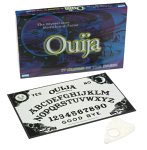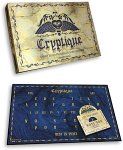|
[an error occurred while processing this directive]
|
Ouija Boards - Just a Game?By Jeff Belanger"Yes, Yes," the direct translation of "Ouija." "Oui," the French word for "yes," and "Ja," the German word for "yes." To many it's thought of as just a game. Today you can buy a Ouija board, also known as a "talking board," in just about any toy store-they are manufactured by Hasbro, the same company that brings us Monopoly and Scrabble. There are also specialty designers who make custom boards, and you can even make your own. But to some practitioners of the occult, the Ouija board is anything but a game. Some consider it a portal that is opened to another realm-something that amateurs shouldn't trifle with. "Spirits can take up residency in just about anything if they feel welcome, and your Ouija is no exception," said Jenny, a ghost enthusiast from Ione, California. "I believe wholeheartedly...Ouija boards are bad!" The first time I tried a Ouija board, I was about 12 years old. It was this first experience with the board game that sparked my interest in the supernatural. I was living in Newtown, Connecticut, and two friends and I got together almost every day during our summer break from school. It was during a sleepover that we looked through a stack of board games and found the Ouija board. We sat down and put our hands on the heart-shaped "Planchette," and it began to move around the board. "Are you moving it?" we would ask each other almost in unison. "I swear, I'm not moving it," would be the reply. The device users lay their hands on what is called the "Planchette," named after its French spiritualist inventor. The original "Planchette" was designed in 1853 to be a spirit communication device. It had a small hole near the center to hold a pencil, and when the users would place their hands on it lightly, the Planchette would move around on a piece of paper underneath and spell out words, draw symbols, and give other messages from the spirit world. Planchette was one of the first pioneers to take a product to the masses for the purpose of spirit communication, and his original design would be copied and transformed over the next 60 years. In the 1860s, Kirby and Company made a mahogany "Kirby's Planchette" version for commercial sale. Kirby's design was simple-a plain wooden paddle on three legs. In 1875, Selchow and Righter gave the Planchette a slightly more fancy shape and packaged their product as "Planchette the Mystic of Mystics." Soon after Selchow and Righter, a man named Charles Kennard launched his version of the Planchette with the word "OUIJA" branded into the wood. During the mid- to late-1800s, a British company launched their own version of the Planchette complete with "Physio-Psychophone" -- basically a flat Planchette (no legs) with a hole in it that can either hold a pencil or go over a folded piece of paper with the alphabet printed on it. In 1915, William Fuld placed a circular window near the point of the Planchette and changed the piece of paper underneath to a wooden board with the alphabet printed on it. The Planchette was used the same way as before, but this time the window would stop over each letter to spell out a message. Fuld didn't invent the Ouija board by any means, but he did put it into a commercial package that hasn't has changed very much in almost 90 years. Fuld would sell his patented Ouija board design to the Milton Bradley game company, who took the commercialization of the product even further. Today, Hasbro owns Milton Bradley and still produces the Ouija board. Hasbro's contribution to the device's evolution is a glow-in-the-dark version. But is the Ouija board Hasbro's "dirty little secret"? If you search the Hasbro Web site, you will find no mention of the Ouija board product anywhere. And Hasbro's public relations department refused to return my calls when asked for an interview regarding their marketing efforts on the Ouija board. So is it "just a game"? During my summer of Ouija board experimentation, we tried various experiments, such as blindfolding the two users and having a third person keep watch for the message. To me, this would have provided indisputable proof that these things were for real. Our hopes were high, and we were patient, but our experiment failed. The Planchette did move around, but it couldn't find the letters very well, and couldn't spell out anything comprehensible. Now, I'm not saying this proves Ouija boards are bunk, by any means. It is possible that the spirit needs to use the mediums' (the board users') senses (i.e., sight) to spell out words. And there are many other possibilities as to why it didn't work. My only point is that if the experiment had worked, it would have erased a lot of doubt. For almost 150 years now, the Ouija board has captivated its users. The device is one of the most successful and prominent icons in spiritualism and ghost study today. Whether the device is a game or a potentially dangerous doorway into the spirit world is for each individual user to decide.
| | ||||||




